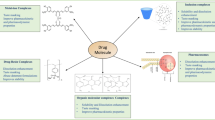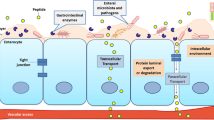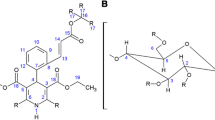Abstract
Background
The search for a simple and scalable approach that can improve the two key biopharmaceutical processes (solubility and permeability) for BCS Class II and BCS Class IV has still been unmet need.
Purpose
In this study, L-lysine was investigated as a potential excipient to tackle problems with solubility and permeability. Bendazac (Class II); quercetin and rutin (Class IV) were employed.
Methods
Drugs-lysine complexes in 1:1 M ratios were prepared by co-precipitation and co-grinding; characterized for solubility, partition coefficient, DSC, FTIR, SEM, dissolution rate and permeability. Chemical stability of quercetin-lysine and rutin-lysine was studied by assessing antioxidant capacity using Trolox and CUPRAC assays.
Results and Conclusion
Drugs-lysine salt/complexes were confirmed. Solubility enhancement factors ranged from 68- to 433-fold increases and dissolution rates were also significantly enhanced by up to 6-times, compared with drugs alone. With the exception of rutin-lysine, Papp for bendazac-lysine and quercetin-lysine enhanced by 2.3- to 4-fold. Papp for quercetin (Class IV) benefited more than bendazac (Class II) when complexed with lysine. This study warrants the use of L-lysine as a promising excipient for enhanced solubility and permeability of Class II and Class IV, providing that the solubility of the drug is ensured at ‘the door step’ of absorption sites.
















Similar content being viewed by others
Abbreviations
- BCS:
-
Biopharmaceutics classification system
- CUPRAC:
-
Cupric ion reducing antioxidant capacity
- DSC:
-
Differential scanning calorimetry
- FTIR:
-
Fourier transform infrared spectroscopy
- Papp :
-
Apparent permeability coefficient
- SEM:
-
Scanning electron microscopy
References
Amidon GL, Lennernas H, Shah VP, Crison JR. A theoretical basis for a biopharmaceutic drug classification: the correlation of in vitro drug product dissolution and in vivo bioavailability. Pharm Res. 1995;12:413–20.
Ghadi R, Dand N. BCS class IV drugs: highly notorious candidates for formulation development. J Control Release. 2017;248:71–95.
Giliyar C, Fikstad DT, Tyavanagimatt S. Challenges and opportunities in oral delivery of poorly water-soluble drugs. Drug Deliv Technol. 2006;6:57–63.
Dahan A, Miller JM, Amidon GL. Prediction of solubility and permeability class membership: provisional BCS classification of the world's top oral drugs. AAPS J. 2009;11:740–6.
Loftsson T. Drug solubilization by complexation. Int J Pharm. 2017;531:276–80.
ElShaer A, Hanson P, Mohammed A. A novel concentration dependent amino acid ion pair strategy to mediate drug permeation using indomethacin as a model insoluble drug. Eur J Pharm Sci. 2014;62:124–31.
Khoder M, Abdelkader H, ElShaera A, Karam A, Najlahd M, Alany R. Efficient approach to enhance drug solubility by particle engineering of bovine serum albumin. Int J Pharm. 2016;515:740–8.
Ahuja M, Dhake AS, Sharma SK, Majumdar DK. Topical ocular delivery of NSAIDs. AAPS J. 2008;10:229–41.
Kumar S, Pandey AK. Chemistry and biological activities of flavonoids: an overview. ScientificWorldJournal. 2013;2013:162750.
Rich GT, Buchweitz M, Winterbone MS, Kroon PA, Wilde PJ. Towards an understanding of the low bioavailability of quercetin: a study of its interaction with intestinal lipids. Nutrients. 2017;9:111.
Majumdar S, Srirangam R. Potential of the bioflavonoids in the prevention/treatment of ocular disorders. J Pharm Pharmacol. 2010;62:951–65.
Balfour JA, Clissold SP. Bendazac lysine. A review of its pharmacological properties and therapeutic potential in the management of cataracts. Drugs. 1990;39:575–96.
Lewis BS, Harding J. The major metabolite of bendazac inhibits the glycosylation of soluble proteins: a possible mechanism for a delay in cataractogenesis. Exp Eye Res. 1988;47:217–25.
Lewis BS, Rixon KC, Harding JJ. Bendazac prevents cyanate binding to soluble lens protiens and cyanate-induced phase separation opacities in vitro: a possible mechanism by which bendazac could delay cataract. Exp Eye Res. 1986;43:973–9.
Abdelkader H, Alany RG, Pierscionek B. Age-related cataract and drug therapy: opportunities and challenges for topical antioxidant delivery to the lens. J Pharm Pharmacol. 2014; In Press
Kim SJ, Flach AJ, Jampol LM. Nonsteroidal anti-inflammatory drugs in ophthalmology. Surv Ophthalmol. 2010;55:109–33.
Abdelkader H, Longman M, Alany R, Piescionek B. Phytosome-hyaluronic acid systems for ocular delivery of L-carnosine. Int J Nanomedicine. 2016;(11):2815–27.
Huang HS, Schoenwald RD, Lach JL. Corneal penetration behavior of Beta blocking agents II: assessment of barrier contributions. J Pharm Sci. 1983;72:1272–9.
Schoenwald RD, Huang HS. Corneal penetration behavior of beta blocking agents I: physichochemical factors. J Pharm Sci. 1983;72:1266–72.
Piel G, Pirotte B, Delneuville I, Neven P, Llabres G, Delarge J, et al. Study of the influence of both cyclodextrins and l-lysine on the aqueous solubility of nimesulide; isolation and characterization of nimesulide-l-lysine-cyclodextrin complexes. J Pharm Sci. 1997;86:475–80.
Abdelkader H, Wu Z, Al-Kassas R, Brown J, Alany R. Preformulation characteristics of the opioid growth factor antagonist-naltrexone hydrochloride: stability and lipophilicity studies. J Drug Delivery Sci Technol. 2011;21:157–63.
Florence AT, Attwood D. The solubility of drugs. In: Florence AT, Attwood D, editors. Physichochemical principles of pharmacy. London: McMillan Press Ltd; 1998. p. 152–97.
Wu Z, Tucker IG, Razzak M, Medlicott N. Physichochemical characterisation of ricobendazole: I. Solubility, lipophilicity and ionization charactersitics. J Pharm Sci. 2005;94:983–93.
Abdelkader H, Longman M, Alany R, Pierscionek B. On the anti-cataractogenic effects of L-carnosine: is it best described as an antioxidant, metal chelating agent or glycation inhibitor? Oxid Med Cell Longev. 2016;2016:1–11.
Apak R, Güçlü K, Özyürek M, Çelik SE. Mechanism of antioxidant capacity assays and the CUPRAC (cupric ion reducing antioxidant capacity) assay. Microchimica Acta. 2008;160:413–9.
Nikghalb L, Singh G, Singh G, Kahkeshan KF. Solid dispersion: methods and polymers to increase the solubility of poorly soluble drugs. Journal of Applied Pharmaceutical Science. 2012;2:170–5.
Nokhodchi A, Talari R, Valizadeh H, Jalali M. An investigation on the solid dispersions of Chlordiazepoxide. Int J Biomed Sci. 2007;3:211–6.
Shore PA, Brodie BB, Hogben CAM. The gastric secretion of drugs: a pH partition hypothesis. J Pharmacol Exp Ther. 1957;119:61–369.
Li B, Konecke S, Harich K, Wegiel L, Taylor L, Edgar K. Solid dispersion of quercetin in cellulose derivative matrices influences both solubility and stability. Carbohydr Polym. 2013;92:2033–40.
Abdelkader H, Abdallah OY, Salem H. Comparison of the effect of tromethamine and polyvinylpyrrolidone on dissolution properties and analgesic effect of nimesulide. AAPS PharmSciTech. 2007;8(3):E1–8.
Hamishehkar H, Emami S, Lamei B, Valizadeh H, .Jouyban A. Evaluation of solubility and dissolution profile of itraconazole after cogrinding with various hydrophilic carriers. J Drug Delivery Sci Technol 2014;24:653–658.
Pietta P-G. Flavonoids as antioxidants. J Nat Prod. 2000;63:1035–42.
Ashrafa O, Nasr M, Nebsen M, Said A, Sammour O. In vitro stabilization and in vivo improvement of ocular pharmacokinetics of the multi-therapeutic agent baicalin: delineating the most suitable vesicular systems. Int J Pharm. 2018;539:83–94.
Gowthamarajan K, Singh S. Dissolution testing for poorly soluble drugs: a continuing perspective. Dissolut Technol. 2010;8:24–32.
Abdelkader H, Alany R. Controlled and continuous release ocular drug delivery systems: pros and cons. Curr Drug Deliv. 2012;9:421–30.
Jarvinen K, Jarvinen T, Urtti A. Ocular absorption following topical delivery. Adv Drug Deliv Rev. 1995;16:3–19.
Kaur IP, Kanwar M. Ocular preparations:the formulation approach. Drug Dev Ind Pharm. 2002;28:473–93.
Lang JC. Ocular drug delivery conventional ocular formulations. Adv Drug Deliv Rev. 1995;16:39–43.
Author information
Authors and Affiliations
Corresponding author
Rights and permissions
About this article
Cite this article
Abdelkader, H., Fathalla, Z. Investigation into the Emerging Role of the Basic Amino Acid L-Lysine in Enhancing Solubility and Permeability of BCS Class II and BCS Class IV Drugs. Pharm Res 35, 160 (2018). https://doi.org/10.1007/s11095-018-2443-0
Received:
Accepted:
Published:
DOI: https://doi.org/10.1007/s11095-018-2443-0




